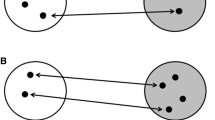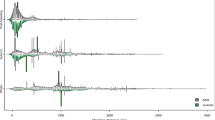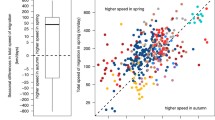Abstract
The three main energy-demanding events in the yearly cycles of birds—breeding, moult and migration—tend to occur at different times of year from one another, with minimal overlap. The sequence in which these various events occur varies according to the ecological conditions (including those encountered during migration) in which particular populations live, and in general, moult is more variable in timing than other events. Some migratory birds moult in their breeding areas after nesting is over, others moult at a staging area on migration, while others moult in winter quarters. Yet others show a split moult, replacing part of their plumage in one place and part in another, moult usually being arrested during the intervening migration. Split moults are often associated with split migrations, as the birds pause for several weeks on their journeys to replace their feathers. Different variants in these patterns occur in different geographical populations of the same species. Some types of birds overlap breeding and moult, and some also overlap moult and migration, especially body moult, which can occur without reducing flight efficiency. A few bird species, with short breeding cycles, have been found to nest in two different areas in a single year, separated by migration. In species in which the young are raised by only one parent, the other parent is able to begin post-breeding moult or migration at a much earlier date. In species in which individuals do not breed in their early years of life, moults and migrations are shifted into the more favourable period which in older birds is occupied by breeding. The main message of this review is the huge variation that occurs in the annual cycles of birds, in the timing and duration of different processes, the sequence in which they occur, and the degree of overlap between them. Variations occur not only between species and populations but also between sex and age-groups within the same population. It is suggested that many species remain in a state of suspended readiness for breeding, moult or migration, and can undertake any of these processes over a greater part of the year than that in which they are normally expressed. Two or more of these processes can remain in this state of readiness simultaneously, enabling the bird to suppress, advance or delay a particular process, according to the conditions in which it finds itself.

Similar content being viewed by others
Notes
Wingfield (2005) and others called the different annual cycle processes of birds ‘life history stages’. This term is usually used for the once-only stages that animals pass through during their development: in the case of birds, the egg, chick, juvenile and adult stages. When the same term is also applied to the annual cycle events of birds and other long-lived organisms, these events (= life history stages) are repeatable each year through the adult life span.
References
Aebischer NJ, Potts GR (1994) Quail Coturnix coturnix. In: Tucker GM, Heath MF (eds) Birds in Europe. Their conservation status. Birdlife International, Cambridge, pp 222–223
Arendt WJ, Vargas Mora TA, Wiley JW (1979) White-crowned pigeon: status rangewide and in the Dominican Republic. Proc Conf SE Assoc Fish Wildl Agencies 33:111–122
Ashmole NP (1963) The biology of the wideawake or sooty tern Sterna fuscata on Ascension Island. Ibis 103b:297–364
Bairlein F (2003) Nutritional strategies in migratory birds. In: Berthold P, Gwinner E, Sonnenschein E (eds) Avian migration. Springer, Berlin, pp 321–332
Barta Z, McNamara JM, Houston AI, Weber TP, Hedenström A, Feró O (2008) Optimal moult strategies in migratory birds. Philos Trans R Soc Lond B 363:211–229
Bensch S, Hasselquist D, Hedenström A, Ottosson U (1991) Rapid moult among palaearctic passerines in West Africa—an adaptation to the oncoming dry season? Ibis 133:47–52
Berthold P (1993) Bird migration. A general survey. Oxford University Press, Oxford
Berthold P (1996) Control of bird migration. Chapman & Hall, London
Bluhm C (1988) Temporal patterns of pair formation and reproduction in annual cycles and associated endocrinology in waterfowl. Curr Ornithol 5:123–185
Bojarinova J, Ilves A, Chernetsov N, Leivits A (2008) Body mass, moult and migration speed of the goldcrest Regulus regulus in relation to the timing of migration at different sites of the migration route. Ornis Fenn 85:55–65
Branson NJBA, Ponting ED, Minton CDT (1979) Turnstone populations on the Wash. Bird Study 26:47–54
Brown LH (1966) Observations on some Kenya eagles. Ibis 108:531–572
Bucher EH (1982) Colonial breeding of the eared dove (Zenaida auriculata) in northeastern Brazil. Biotropica 14:255–261
Buehler DM, Piersma T (2008) Travelling on a budget: predictions and ecological evidence for bottlenecks in the annual cycle of long distance migrants. Philos Trans R Soc Lond B 363:247–266
Catry T, Ramos JA, Le Corre M, Phillips RA (2009) Movements, at-sea distribution and behaviour of a tropical pelagic seabird: the wedge-tailed shearwater in the western Indian Ocean. Mar Ecol Prog Ser 391:231–242
Cramp S (1985) The birds of the Western Palearctic, vol 4. Oxford University Press, Oxford
Cramp S (1988) The birds of the Western Palearctic, vol 5. Oxford University Press, Oxford
Cramp S (1992) The birds of the Western Palearctic, vol 6. Oxford University Press, Oxford
Cramp S, Perrins CM (1993) The birds of the Western Palearctic, vol 7. Oxford University Press, Oxford
Cramp S, Perrins CM (1994a) The birds of the Western Palearctic, vol 8. Oxford University Press, Oxford
Cramp S, Perrins CM (1994b) The birds of the Western Palearctic, vol 9. Oxford University Press, Oxford
Cramp S, Simmons KEL (1977) The birds of the Western Palearctic, vol 1. Oxford University Press, Oxford
Cramp S, Simmons KEL (1980) The birds of the Western Palearctic, vol 2. Oxford University Press, Oxford
Cramp S, Simmons KEL (1983) The birds of the Western Palearctic, vol 3. Oxford University Press, Oxford
Dittman T, Becker PH (2003) Sex, age, experience and condition as factors affecting arrival date in prospecting common terns, Sterna hirundo. Anim Behav 65:981–986
Elliott CCH, Waltner M, Underhill LG, Pringle JS, Dick WJA (1976) The migration system of the curlew sandpiper Calidris ferruginea in Africa. Ostrich 47:191–213
Evans PR, Davidson NC (1990) Migration strategies and tactics of waders breeding in arctic and north temperate latitudes. In: Gwinner E (ed) Bird migration. Physiology and ecophysiology. Springer, Berlin, pp 387–398
Flinks H, Helm B, Rothery P (2008) Plasticity of moult and breeding schedules in migratory European stonechats Saxicola rubicola. Ibis 150:687–697
Gibbs HL, Grant PR (1987) Ecological consequences of an exceptionally strong El Niño event on Darwins finches. Ecology 68:1735–1746
Gill RE Jr, Tibbits TL, Douglas DC, Handel CM, Mulcahy BJ, Battley PF, Piersma T (2009) Extreme endurance flights by landbirds crossing the Pacific Ocean: ecological corridor rather than barrier? Proc R Soc B 276:447–457
Goss-Custard JD, Le V dit Durell SEA, Sitters HP, Swinfen R (1982) Age-structure and survival of a wintering population of oystercatchers. Bird Study 29:83–98
Götmark F (1982) Irruptive breeding of the redpoll, Carduelis flammea, in south Sweden in 1975. Vår Fågelvärld 41:315–322
Grubb TG, Bowerman WW, Howey PW (1994) Tracking local and seasonal movements of wintering bald eagles Haliaeetus leucocephalus. In: Meyburg B-U, Chancellor RD (eds) Raptor conservation today. Pica Press, London, pp 347–358
Guilford TC, Meade J, Willis J, Phillips RA, Boyle D, Roberts S, Collett M, Freeman R, Perrins CM (2009) Migration and stopover in a small pelagic seabird, the Manx shearwater Puffinus puffinus: insights from machine learning. Proc R Soc Lond B 276:1215–1223
Gwinner E (1986) Circannual rhythms. Springer, Berlin
Halley DJ, Harris MP, Wanless S (1995) Colony attendance patterns and recruitment in immature common murres (Uria aalge). Auk 112:947–957
Hamilton WJ (1998) Tricolored blackbird itinerant breeding in California. Condor 100:218–226
Hatch SA (1983) Mechanism and ecological significance of sperm storage in the northern fulmar with reference to its occurrence in other birds. Auk 100:593–600
Hedenström A, Alerstam T (1998) How fast can birds migrate? J Avian Biol 29:424–432
Helm B, Gwinner E, Trost L (2005) Flexible seasonal timing and migratory behaviour. Results from stonechat breeding programmes. Ann N Y Acad Sci 1046:216–227
Hémon YA, Saint-Jalme M, Guyomarc’h JC (1988) Structure et functtionnement des populations reproductrices ‘français’ de Cailles des blé. Bull. Mensuel de l’Office National de la Chasse 127:29–32
Hockey PAR, Turpie JK, Velásquez CR (1998) What selective pressures have driven the evolution of deferred northward migration by juvenile waders? J Avian Biol 29:325–330
Hötker H (2002) Arrival of pied avocets Recurvirostra avosetta at the breeding site: effects of winter quarters and consequences for reproductive success. Ardea 90:379–387
Jaeger MM, Bruggers RL, Johns BE, Erickson WA (1986) Evidence of itinerant breeding of the red-billed quelea Quelea quelea in the Ethiopian Rift Valley. Ibis 128:469–482
Jehl JR (1990) Aspects of the moult migration. In: Gwinner E (ed) Bird migration: physiology and ecophysiology. Springer, Berlin, pp 102–113
Jenni L, Winkler R (1994) Moult and ageing of European passerines. Academic, London
Jones PJ (1995) Migration strategies of Palearctic passerines in Africa: an overview. Israel J Zool 41:393–406
Kjellén N (1992) Differential timing of autumn migration between sex and age groups in raptors at Falsterbo, Sweden. Ornis Scand 23:420–434
Kjellén N (1994) Moult in relation to migration in birds—a review. Ornis Svecica 4:1–24
Koford CB (1953) The California condor. Nat Audubon Soc Res Rep 4:1–154
Lack D (1954) The natural regulation of animal numbers. Oxford University Press, Oxford
Ligon JD (1971) Late summer-autumnal breeding of the Pinyon jay in New Mexico. Condor 73:147–153
Lindström Å, Piersma T (1993) Mass changes in migrating birds–the evidence for fat and protein storage reexamined. Ibis 135:70–78
Lloyd CS, Perrins CM (1977) Survival and age at first breeding in the razorbill (Alca torda). Bird Banding 48:239–252
McNamara JM, Houston AI (2008) Optimal annual routines: behaviour in the context of physiology and ecology. Philos Trans R Soc Lond B 363:301–319
McNeil R, Diaz MT, Villeneuve A (1994) The mystery of shorebird over summering: a new hypothesis. Ardea 82:143–152
Meltofte H (1996) Are African wintering waders really forced south by competition from northerly wintering conspecifics? Benefits and constraints of northern versus southern wintering and breeding in waders. Ardea 84:31–44
Metcalfe NB, Furness RW (1985) Survival, winter population stability and site-fidelity in the turnstone Arenaria interpres. Bird Study 32:207–214
Meyburg B-U, Meyburg C (1999) The study of raptor migration in the Old World using satellite telemetry. Proc Int Ornithol Congr 22:2992–3006
Meyburg B-U, Schiller W, Meyburg C (1995) Migration and wintering of the lesser spotted eagle (Aquila pomarina)—a study by means of satellite telemetry. J Ornithiol 136:401–422
Meyburg B-U, Meyburg C, Balkan T, Šreibr O, Vrana J (2004) Migration, wintering and breeding of a lesser spotted eagle (Aquila pomarina) from Slovakia tracked by satellite. J Ornithol 145:1–7
Miller AH (1954) Breeding cycles in a constant equatorial environment in Columbia, South America. Proc Int Ornithol Congr 11:495–503
Miller AH (1959) Reproductive cycles in an equatorial sparrow. Proc Natl Acad Sci USA 45:1075–1100
Moreau RE (1951) The British status of the quail and some problems of its biology. Br Birds 44:257–276
Murphy M (1999) Energetics and nutrition of moulting. In: Adams NJ, Slotow RH (eds) Proceedings of the 22nd international ornithological congress, Durban, pp 527–535
Murton RK, Westwood NJ (1977) Avian breeding cycles. Clarendon Press, Oxford
Myers JP (1981) A test of three hypotheses for latitudinal segregation of the sexes in wintering birds. Can J Zool 59:1527–1534
Newton I (1972) Finches. Collins, London
Newton I (1999) An alternative approach to the measurement of seasonal trends in bird breeding success: a case study of the bullfinch Pyrrhula pyrrhula. J Anim Ecol 68:698–707
Newton I (2007) Weather-related mass-mortality events in migrants. Ibis 149:453–467
Newton I (2008) The migration ecology of birds. Academic, London
Newton I, Marquiss M (1982) Moult in the sparrowhawk. Ardea 70:163–172
Newton I, Rothery P (2005) The timing, duration and pattern of moult and its relationship to breeding in a population of the European greenfinch Carduelis chloris. Ibis 147:667–679
Noskov GA, Rymkevich TA, Iovchenko NP (1999) Intraspecific variation of moult: adaptive significance and ways of realisation. In: Adams NJ, Slotow RH (eds) Proceedings of the 22nd international ornithological congress, Durban, pp 544–563
Oring LW, Lank DB (1982) Sexual selection, arrival times, philopatry and site fidelity in the polyandrous spotted sandpiper. Behav Ecol Sociobiol 10:185–191
Payevsky VA (1994) Age and sex structure, mortality and spatial winter distribution of siskins (Carduelis spinus) migrating through eastern Baltic area. Die Vogelwarte 37:190–198
Payne RB (1969) Breeding seasons and reproductive physiology of tricolored backbirds and red-winged blackbirds. Univ Calif Publ Zool 90:1–115
Peiponen VA (1967) Südliche Fortpflanzung und Zug von Carduelis flammea (L.) in Jahre 1965. Ann Zool Fenn 4:547–549
Perrins CM, Harris MP, Britton CK (1973) Survival of Manx shearwaters Puffinus puffinus. Ibis 115:535–548
Phillips RA, Silk JRD, Croxall JP, Afanasyev V (2006) Year-round distribution of white-chinned petrels from South Georgia: relationships with oceanography and fisheries. Biol Conserv 129:336–347
Phillips RA, Catry P, Silk JRD, Bearhop S, McGill R, Afanasyev V, Strange IJ (2007) Movements, winter distribution and activity patterns of Falkland and brown skuas: insights from loggers and isotopes. Mar Ecol Prog Ser 345:281–291
Pulido F, Berthold P (2003) Quantitative genetic analyses of migratory behaviour. In: Berthold P, Gwinner E, Sonnenschein E (eds) Avian migration. Springer, Berlin, pp 53–77
Rogers DT (2006) Hidden costs: challenges faced by migratory shorebirds living on intertidal flats. PhD thesis, Charles Sturt University, Australia
Rohwer S (1999) Time constraints and moult-breeding tradeoffs in large birds. In: Adams NJ, Slotow RH (eds) Proceedings of the 22nd international ornithological congress, Durban, pp 568–581
Rohwer S, Hobson KA, Rohwer VG (2009) Migratory double breeding in neotropical migrant birds. Proc Natl Acad Sci USA 106:19050–19055
Salomonsen F (1968) The moult migration. Wildfowl 19:5–24
Schreiber EA, Burger J (2002) Biology of marine birds. CPR Press, New York
Schwabl H (1983) Ausprägung und Bedeutung des Teilzugverhaltens einer sudwestdeutschen Population der Amsel Turdus merula. J Ornithol 124:101–115
Serra L (1998) The adaptation of primary moult to migration and wintering in the grey plover (Pluvialis squatarola): a preliminary outlook. Biol Conserv Fauna 102:123–127
Serra L (2000) How do Palaearctic grey plovers adapt primary moult to time constraints? An overview across four continents. Wader Study Group Bull 93:11–12
Shaffer SA, Tremblay Y, Weimerskirsch H, Scott D, Thompson DR, Sagar PM, Moller H, Taylor GA, Foley DG, Block BA, Costa DP (2006) Migratory shearwaters integrate oceanic resources across the Pacific Ocean in an endless summer. Proc Natl Acad Sci USA 1103:2799–2802
Shirihai H, Yosef R, Alon D, Kirwan GM, Spaar R (2000) Raptor migration in Israel and the Middle East. A summary of 30 years of field research. International Birding & Research Centre, Israel
Smith HG, Nilsson J-A (1987) Intraspecific variation in migratory pattern of a partial migrant, the blue tit (Parus caeruleus): an evaluation of different hypotheses. Auk 104:109–115
Snow DW (1962) A field study of the black-and-white manakin, Manacus manacus, in Trinidad. Zoologica 47:65–104
Snow DW (1965) The breeding od Audubon’s shearwater (Puffinus lherminieri) in the Galapagos. Auk 82:591–597
Sohle LS, Robertson CJR, Nicholls DG, Mouritsen H, Frost B, Moller H (2007) Satellite tracking of sooty shearwaters (Puffinus griseus) during their pre-laying exodus and incubation. Notornis 54:180–188
Stresemann E, Stresemann V (1966) Die Mauser der Vögel. J Ornithol 107:3–448
Summers RW, Underhill LG, Prys-Jones RP (1995) Why do young waders in southern Africa delay their first return migration to the breeding grounds? Ardea 83:351–357
Thomson CW (1991) The sequence of moults and plumages in painted buntings and implications for theories of delayed plumage maturation. Condor 93:209–235
Underhill LG (2003) Within ten feathers: primary moult strategies of migratory waders (Charadrii). In: Berthold P, Gwinner E, Sonnenschein E (eds) Avian migration. Springer, Berlin, pp 187–197
Ward P (1971) The migration patterns of Quelea quelea in Africa. Ibis 113:275–297
Ward P, Jones PJ (1977) Pre-migratory fattening in three races of the red-billed quelea Quelea quelea (Aves: Ploceidae), an intra-tropical migrant. J Zool Lond 181:43–56
Warham J (1990) The petrels. Their ecology and breeding systems. Academic, London
Whitfield DP (2002) Dotterel. In: Wernham CV, Toms MP, Marchant JH, Clark JA, Siriwardena GM, Baillie SR (eds) The migration atlas: movements of the birds of Britain and Ireland. Poyser, London, pp 281–283
Wingfield JC (2005) Flexibility in annual cycles of birds: implications for endocrine control mechanisms. J Ornithol 146:291–304
Wingfield JC (2008) Organisation of vertebrate annual cycles: implications for control mechanisms. Philos Trans R Soc Lond B 363:425–441
Wyllie I (1981) The cuckoo. Batsford, London
Zann RA, Morton SR, Jones KR, Burley NT (1995) The timing of breeding by zebra finches in relation to rainfall in central Australia. Emu 95:208–222
Author information
Authors and Affiliations
Corresponding author
Additional information
Communicated by F. Bairlein.
Rights and permissions
About this article
Cite this article
Newton, I. Migration within the annual cycle: species, sex and age differences. J Ornithol 152 (Suppl 1), 169–185 (2011). https://doi.org/10.1007/s10336-011-0689-y
Received:
Revised:
Accepted:
Published:
Issue Date:
DOI: https://doi.org/10.1007/s10336-011-0689-y




